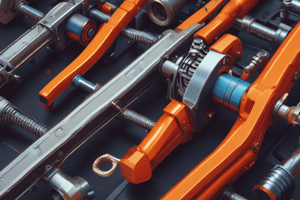Podcast
Questions and Answers
What is a lever?
What is a lever?
A bar or rod that tilts on a pivot (called a fulcrum) to apply a force (effort) to raise a weight or overcome a resistance (load).
What determines the amount of effort and the distance a load moves when using a lever?
What determines the amount of effort and the distance a load moves when using a lever?
The distance the effort and load are from the fulcrum.
What is the principle of levers?
What is the principle of levers?
The effort times its distance from the fulcrum equals the load times its distance from the fulcrum.
What is a first class lever?
What is a first class lever?
What is an example of a first class lever?
What is an example of a first class lever?
What is a second class lever?
What is a second class lever?
What happens in a second class lever as the load moves close to the fulcrum?
What happens in a second class lever as the load moves close to the fulcrum?
What does a second class lever do?
What does a second class lever do?
What part of a wheelbarrow acts as a fulcrum?
What part of a wheelbarrow acts as a fulcrum?
What is the load when a lever is used to press on an object?
What is the load when a lever is used to press on an object?
What is a compound lever?
What is a compound lever?
What are some examples of compound levers?
What are some examples of compound levers?
What is a third class lever?
What is a third class lever?
What does a third class lever do?
What does a third class lever do?
Compare and contrast second and third class levers.
Compare and contrast second and third class levers.
The type of lever that makes a simple kitchen scale is a ______.
The type of lever that makes a simple kitchen scale is a ______.
The type of levers that make up a bathroom scale are ______.
The type of levers that make up a bathroom scale are ______.
The type of levers that make up platform scales are ______.
The type of levers that make up platform scales are ______.
How many levers are in a typical platform scale?
How many levers are in a typical platform scale?
What is the name for the complex systems of levers used in a piano to transmit the player's movements on the keys to the hammers?
What is the name for the complex systems of levers used in a piano to transmit the player's movements on the keys to the hammers?
What part of the piano's mechanism drops onto the piano wire to cut off the sound that the hammer produces?
What part of the piano's mechanism drops onto the piano wire to cut off the sound that the hammer produces?
What do the pedals on a piano do?
What do the pedals on a piano do?
What is the function of the piano's check and repetition lever?
What is the function of the piano's check and repetition lever?
What type of lever is a brake handle?
What type of lever is a brake handle?
How do bicycle brakes slow and stop a bicycle?
How do bicycle brakes slow and stop a bicycle?
What parts of a hydraulic platform act as levers?
What parts of a hydraulic platform act as levers?
Flashcards are hidden until you start studying
Study Notes
Levers Overview
- A lever is a bar or rod that pivots on a fulcrum to apply force and lift a load.
- The measure of effort needed and the distance a load moves depend on their positions relative to the fulcrum.
Lever Principles
- The principle of levers states that effort times its distance from the fulcrum equals load times its distance from the fulcrum.
Types of Levers
- First Class Lever: Fulcrum is positioned between the effort and the load, e.g., a balance scale.
- Second Class Lever: Fulcrum is at one end; load is between the effort and the fulcrum, magnifying force while reducing distance moved.
- Third Class Lever: Fulcrum is at one end; effort is between the load and the fulcrum, decreasing force but increasing distance moved.
Examples of Levers
- First Class: Balance scales.
- Second Class: A wheelbarrow (wheel acts as fulcrum); increases force as the load moves closer to the fulcrum.
- Third Class: Body movements, such as lifting weights with arms.
Compound Levers
- A compound lever consists of two levers joined at the fulcrum, seen in tools like scissors and nutcrackers.
Scales and Leverage
- In a Roberval kitchen scale, an object can be placed anywhere without affecting the measurement due to the equal distribution of forces.
- Bathroom scales and platform scales utilize both first and third class levers.
Piano Mechanics
- The complex system of levers in a piano, known as the action, transmits the player's keystrokes to the hammers.
- Dampers cut off sound by dropping onto the piano wire after the hammer strikes it.
- The piano's pedals adjust the sound produced, while the check and repetition lever facilitates hammer action.
Bicycle Brakes
- A brake handle functions as a second class lever, applying brake blocks to the wheel rims to create friction and slow down or stop the bicycle.
Hydraulic Platforms
- The booms in hydraulic platforms act as levers, utilizing hydraulic pressure to move payloads efficiently.
Studying That Suits You
Use AI to generate personalized quizzes and flashcards to suit your learning preferences.




